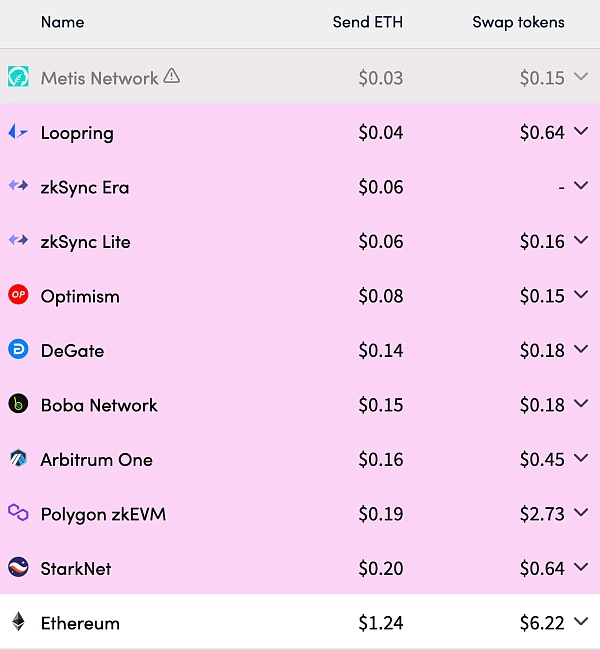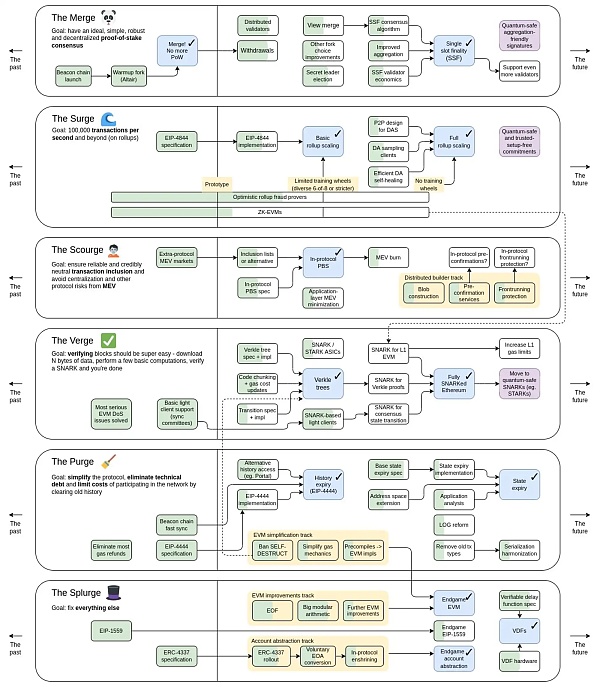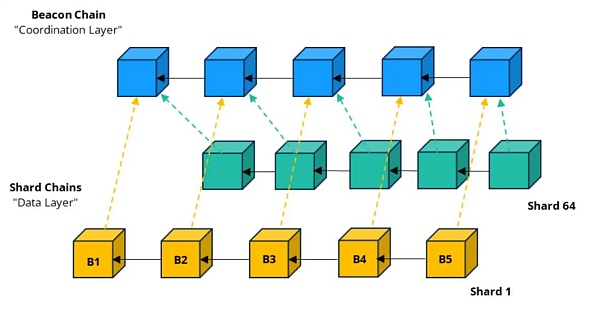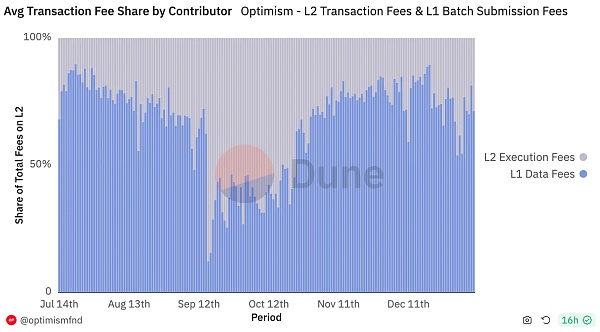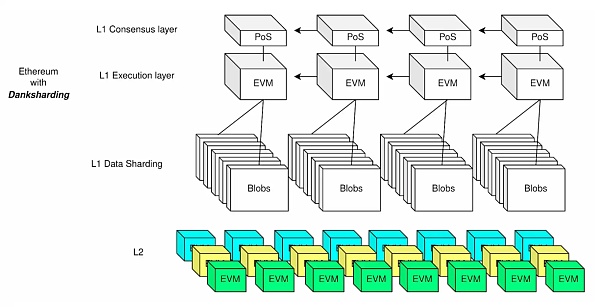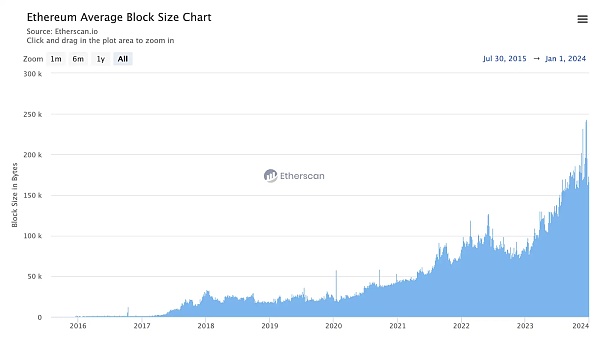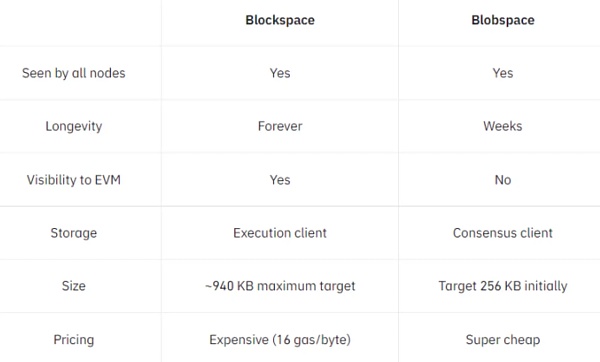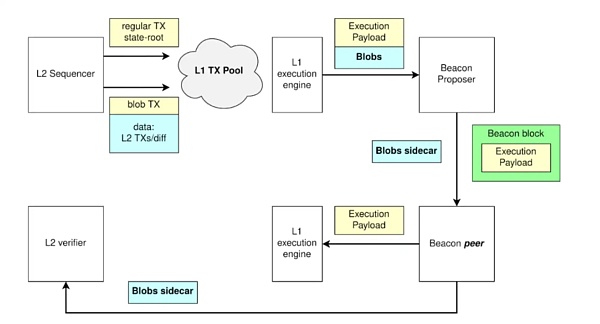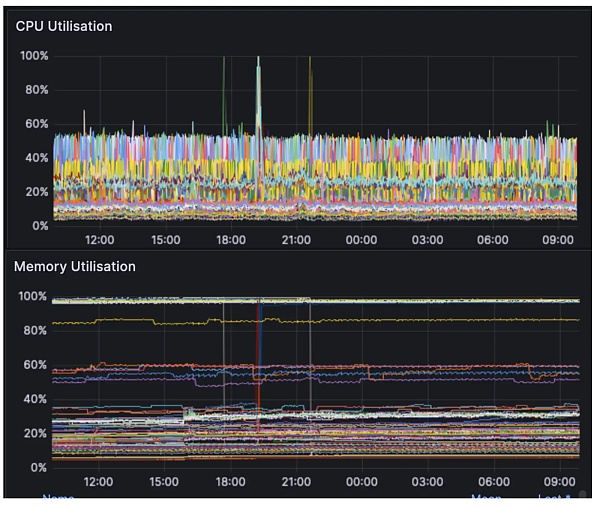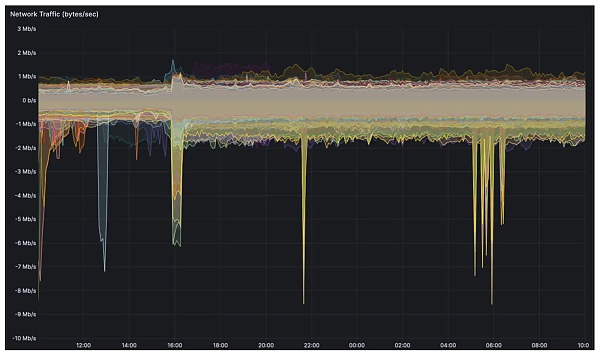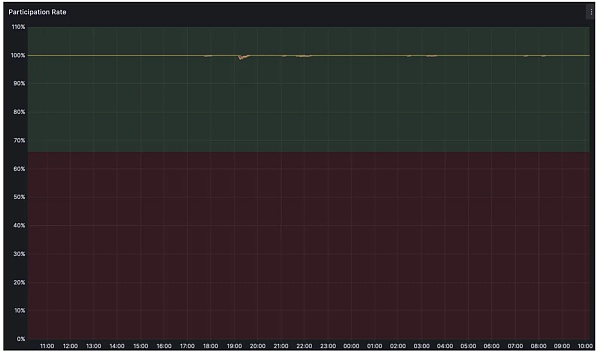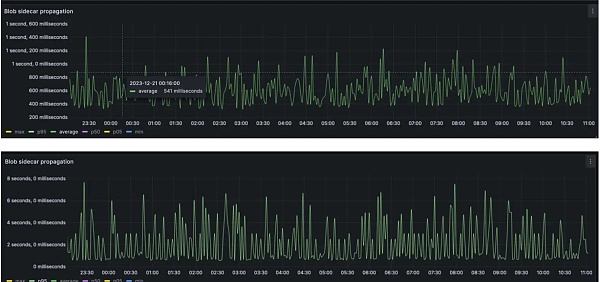The blob will propagate to 95% of the nodes in less than 2 seconds, and on average, most blobs will propagate through the complete network in 500 milliseconds. Ideally, block propagation time is expected to increase by about 250 milliseconds.
source: https://notes.ethereum.org/@ethpandaops/dencun-gsf-1-analysis
< /blockquote>1.4 Conference Call
On the evening of January 4th, No. 178 Ethereum core developer executive meetings were held online. This meeting finalized the testnet Dencun upgrade schedule. The developers unanimously agreed to conduct upgrade tests on the Goerli, Sepolia and Holesky testnets on January 17, January 30 and February 7 respectively.
At the same time, in order to respond quickly and solve possible problems during the test network upgrade process, the developers decided to launch the Goerli test network on January 17th after the completion of the test. The 179th meeting was quickly held the next day to discuss the test content and decide whether it was necessary to update the test network upgrade test schedule according to the situation.
Although developers have not reached a final consensus on the upgrade time of the main network, the current Shadowfork test data, test network test arrangements and time progress Look, the Dencun upgrade of the Ethereum mainnet will most likely be carried out at the end of February.
Potential opportunities and favorable tracks
L2
One of the most direct benefits of Dencun's upgrade is the L2 track. The introduction of blobs has significantly reduced L2 transaction costs and improved throughput to a certain extent. Dencun's excitement for L2 is that it can further compete with other Alt L1s and attract high-quality projects and users from other L1 ecosystems with lower expenses and better performance.

source: https://www.techflowpost.com/article/detail_14912.html
Dencun upgrade is good for all L2 based on Ethereum, but under the universal good, we will focus on observing which L2 projects have more unique competitive advantages and can Get more bonuses from Dencun upgrades.
L2 Ecology
Arbitrum
The current leaders of Ethereum L2 are still Arbitrum and Optimism, but their competitive advantages and segmented competition directions are slightly different. Arbitrum is further ahead in the diversity of protocols based on Arbitrum One, and Optimism is further ahead in the diversity of inter-chain ecosystems based on OP Stack.
Arbitrum is still the most diverse L2 of all protocols. According to incomplete statistics from DeFiLlama, the number of protocols on Arbitrum is approximately 520, far exceeding the second-ranked Optimism’s 216. According to L2beat data, Arbitrum’s current TVL is approximately 11.26B, accounting for nearly half of Ethereum Rollup’s TVL.
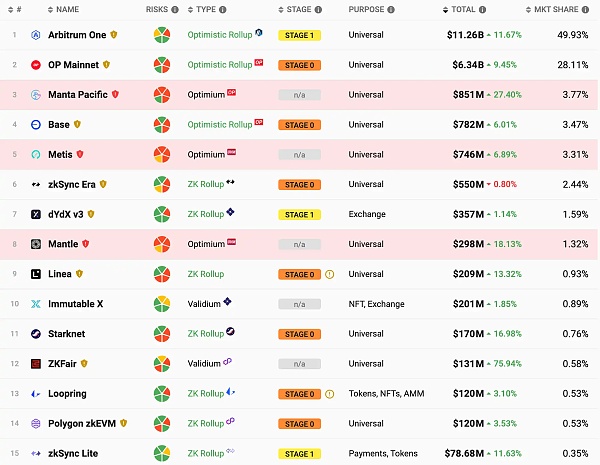
source: https://l2beat.com/scaling/summary
In addition, online trading activity on Arbitrum is also booming. Judging from the ranking of network transaction volume in the past 30 days, Arbitrum has a transaction volume of approximately 36M, ranking second only to zkSync, which has not issued coins yet but still has a lot of hair-raising activities. If we exclude L2, which has airdrop interactions, and only compare Arbitrum and Optimism, which have issued coins, Arbitrum is also far ahead with a network transaction volume that is 3 times that of Optimism.
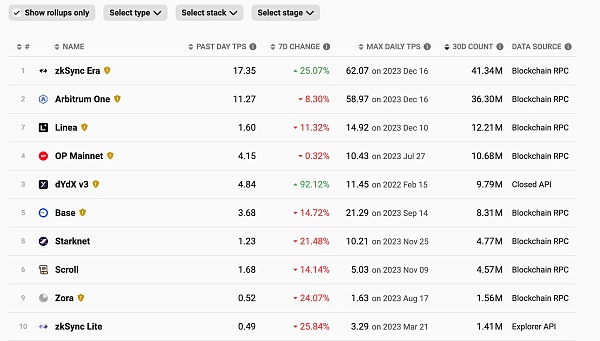
source: https://l2beat.com/scaling/summary
Taken together, Arbitrum, which has the highest network transaction volume, can obviously reap more dividends from reduced transaction fees. The optimization of TPS is also conducive to the higher performance requirements of GMX, GNS, etc. on Arbitrum. The prosperity of the protocol ecosystem. From a network fundamentals perspective, Arbitrum is undoubtedly one of the biggest beneficiaries of the Dencun upgrade. In addition, Arbitrum is also actively promoting the Arbitrum Orbit and Stylus languages, allowing developers to use Orbit to build Rollups based on EVM and WASM VM at the same time, creating Arbitrum-based network effects.
Optimism
Different from Arbitrum, Optimism’s competition The focus is more on the Optimism SuperChain network built based on OP Stack, and the value of Optimism depends more on the network value of Optimism SuperChain.
Since the release of OP Stack, a large number of projects such as Base, Lyra, opBNB, Redstone, Zora, Mode, Debank, etc. have built their own L2 based on OP Stack. . The upgrade of the OP Stack Bedrock version also further optimizes transaction costs, transaction processing within blocks, node performance, etc., making it more attractive to build L2 based on OP Stack. According to the plan of Optimism SuperChain, all Rollups using OP Stack will be integrated into a standardized OP chain. These chains can communicate directly via the cross-chain messaging protocol, sharing a common Ethereum cross-chain bridge and sequencer network.
If the Dencun upgrade can benefit all L2s at the same time, then the upgrade premium enjoyed by Optimism is the combination of network value brought by all Optimism ecological chains. If the Dencun upgrade can spawn more new L2s, then the upgrade premium enjoyed by Optimism is that more L2 chains may be built using OP Stack, and Optimism will get closer and closer to the ultimate vision of the Optimism SuperChain super ecology. .
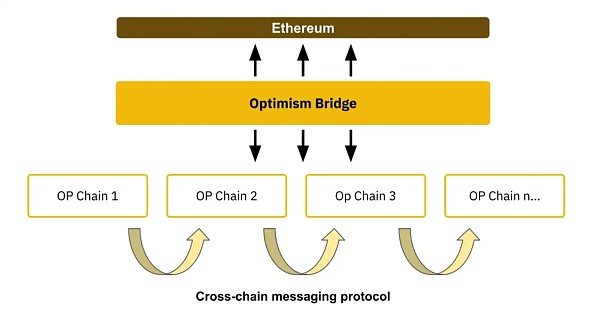
source: https://app.optimism.io/superchain
Sequencer decentralization
Metis
The competition between Arbitrum and Optimism is more about protocols, network activity, ecological value and other aspects. However, another big problem that needs to be solved is the decentralization of L2 Sequencer, which has become the elephant in the room. As the Dencun upgrade brings more L2 explosions, problems such as single points of failure, malicious arbitrage, grabbing MEV value, and censorship of user transaction space caused by centralized sorters may become increasingly serious.
Metis has taken the lead in making changes in this regard and may become the first Ethereum L2 to run a decentralized PoS orderer.
Metis breaks the centralized pattern of sorters and supports nodes that pledge at least 20,000 METIS tokens to enter the sorter pool and become sorter operators. The sequencers entering the sequencer pool will be responsible for determining the packaging order of transactions, and at least 2/3 of the sequencer signatures are required to package and upload the data to the L1 main network. In addition, in order to further prevent the sequencer from doing evil, Metis has also introduced the role of a validator to conduct sample surveys on blocks to ensure that the sequencer sorts the transaction order correctly.
Metis chose to actively give up profits and actively gave away the most profitable sorter income to the pledge nodes. With the emergence of more pledge protocols for sorters in the future, we can also foresee that a wider range of users will be able to participate in sorter pledges and share the sorter profits. Metis' innovation in sorter decentralization and empowerment of METIS tokens have increased the price of METIS tokens, the pledge rate of METIS tokens, and the inflow of funds into the Metis network. With the prosperity of the METIS network ecology and the growth of sorter income, more and more METIS will be pledged to the sorter nodes, and there will be less and less METIS in circulation. The demand for METIS in the market will instead increase. The more, it will promote Metis and METIS tokens to move towards a positive cycle of rising TVL, ecology and currency prices.
The competition for decentralized sorters may become the core theme of L2 competition after Dencun upgrades.
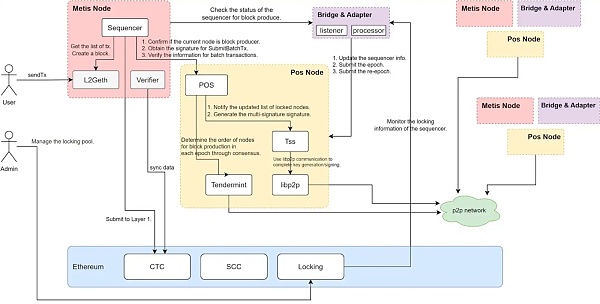
source: https://docs.metis.io/dev/decentralized-sequencer/overview
Token empowerment
Another major factor that determines the price of L2 tokens The core factor is L2’s token empowerment. Currently, almost all Ethereum L2 uses ETH as the Gas token, and its own L2 token has no other use except governance. Without a stable value consumption scenario, the tokens in the hands of users will become discardable pieces at any time. Tokens with actual empowerment, such as METIS, are more likely to move towards a positive spiral in which L2 fundamentals and currency prices rise simultaneously.
In addition to the previously mentioned METIS tokens that can be used as pledge tokens for decentralized sorters and share sorter income, another case worth learning from is ZKF. ZkFair's token ZKF can not only be used as a Gas token, but can also be pledged to share the Gas income of the ZkFair network. Similar to METIS, token empowerment with pledged dividends is also more likely to promote a spiral increase in the ZKF market price. In addition, Arbitrum Orbit has also added the ability to support custom Gas tokens.
As mentioned earlier, all Rollups sharing the OP Stack will share a common sequencer network. Imagine if Optimism also learns from Metis and introduces a module for staking OP to become the OP Stack decentralized sorter. How much market demand and buying power this will bring to OP. The rise in currency prices will in turn attract more funds and users to applications within the ecosystem, feeding back the prosperity of the ecosystem. Ethereum L2’s efforts in token empowerment after the bumpy upgrade are also one of the core issues that need to be focused on.
Others
As mentioned above, Dencun upgrade comes with The coming reduction in transaction fees and increase in L2 TPS will benefit every Ethereum L2. In addition to the projects we discussed in the previous article, there are some other projects whose performance is also worth looking forward to.
Base can be regarded as one of the best-performing L2s in 2023. The strong binding relationship with Coinbase enables Base to accept a large number of users and funds from Coinbase. It has become Ethereum L2, which ranks third in TVL today. The rise of Base is inseparable from the hype of popular projects such as Friend.tech and FrenPet on Base. One of the major characteristics of the above-mentioned projects is that the frequency of interaction is high and the income from a single interaction is low. Moreover, the number of users undertaken is relatively large, and the application has higher performance requirements. The benefits brought by the Dencun upgrade coincide with the needs and characteristics of this type of project. We may see more pan-social and gaming light applications appear on Base, bringing in more users and funds to the Base ecosystem and stimulating the ecological vitality of Base.
In addition, there are more Mantle, Blast and other L2s that have not yet been issued coins and are still accumulating power. This type of L2 attracts users to participate in ecological interactions through currency issuance expectations and superimposed revenue marketing. Dencun upgrade can greatly reduce the cost of user interaction and further promote the prosperity of such L2 chain activities. However, it is worth noting that we still don’t know where this type of L2 will go after the airdrop. At this stage, we can only remain cautiously optimistic about this type of project.
Data availability layer
One of the core modules of Dencun upgrade is the introduction of blob storage Data submitted by L2 to L1. But blob data storage is not permanent, and the stored data will be discarded after about a month or so. However, this part of the data still has the potential value of being called and analyzed. Therefore, the storage of this part of data will also drive the demand for decentralized storage business.
ETHStorage
EthStorage is the first EthStorage based on Ethereum It provides a second-tier solution for programmable dynamic storage based on the availability of data. It can expand programmable storage to hundreds of TB or even PB level at a cost of 1/100 times to 1/1000 times.
ETHStorage is highly integrated with ETH. The EthStorage client is a superset of the Ethereum client Geth, which means that when running an EthStorage node, you can still participate normally. In any process of Ethereum, a node can be a validator node of Ethereum and also a data node of EthStorage.
And ETHStorage has stronger interoperability with EVM and can achieve perfect compatibility with EVM. Taking the Mint NFT image as an example, converting the Mint image stored on Arweave into an NFT image on Ethereum requires three smart contract operations, while ETHStorage only needs one to complete it.
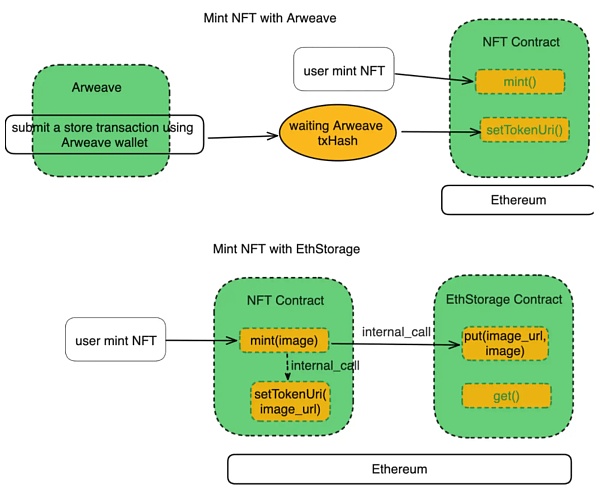
source: https://www.techflowpost.com/article/detail_12801.html
ETHStorage adopts the key-value storage paradigm and supports complete CRUD operations (create, read, update, delete stored data). ETHStorage is positioned as the first storage L2 of the Ethereum ecosystem. Thanks to its seamless interoperability with EVM and low storage costs, ETHStorage is expected to inherit L2 state data discarded by blobs.
Covalent
Another decentralization worthy of attention Storage items are Covalent. Covalent was the first to smell the business opportunities in data availability after the Cancun upgrade, and launched the "Ethereum Wayback Machine (EWM)" in November 2023 for long-term storage of L2 state data discarded by blobs.
Of course, just storing data is of limited value to Covalent, so Covalent is not only a simple storage, but also integrates L2 data into its existing Centralized data analysis infrastructure services. Covalent supports users to seamlessly access blockchain data and provides data service support for specific user groups such as arbitrage traders, MEV researchers, AI researchers, blockchain data websites, etc.
No matter how the execution layer, settlement layer, consensus layer and short-term data availability layer are performed in the future of the modular blockchain, Covalent hopes to be the best choice for all project parties. The long-term data availability layer provides permanent data storage and availability services.
With the implementation of the Cancun upgrade, it is expected that the data storage and availability tracks will usher in a new round of hype. Covalent, which is endorsed by well-known exchanges such as Binance, Coinbase, 1kx, Delphi Digital, and first-tier investment institutions, and has a solid business, will not be at a disadvantage in the competition.

source: https://www.covalenthq.com/docs/covalent-network/ewm-paper/
< /blockquote>Old decentralized storage projects such as Filecoin, Arweave, and Storj
The Cancun upgrade will also bring more practical decentralized storage business needs to established decentralized storage projects such as Filecoin, Arweave, and Storj. It is expected that the above projects will also take over some of the L2 state data discarded by blobs. Since this part of the data is only valuable to some special groups of people who are oriented to data analysis and research, frequent status changes are not required. Therefore, in comparison, Arweave, which focuses on pay-once and permanent storage, may be able to win more growth in the L2 state data storage business.
If we take a long-term view, L2 also needs a dedicated data availability layer. In the long run, what is stored in the blob may not be the data and status submitted by L2, but the Merkel root of this part of the calculation. Let Ethereum no longer bear any additional data storage and return to the most fundamental consensus.
EigenDA
EigenDA is a major DA worth looking forward to solution. EigenDA realizes the decoupling of data availability and consensus. First, Rollup needs to encode the data blob using erasure coding and KZG commitments and publish the KZG commitments. Subsequently, the EigenDA nodes composed of re-pledges need to proofread and verify the KZG commitment and final consensus confirmation. Finally, the data confirmed by consensus will be submitted to the Ethereum main network. The core of EigenDA is to reuse the consensus of Ethereum, abstract the verification and final consensus confirmation links in DA, and complete this part of the work through the reused consensus.
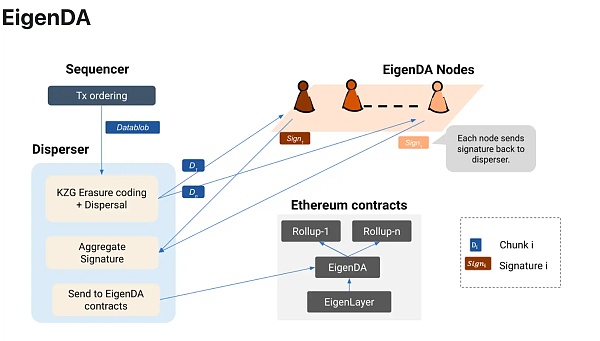
source: https://docs.eigenlayer.xyz/eigenda-guides/eigenda-overview
Polygon Avail
Polygon Avail is a solution proposed by Polygon that focuses on solving the problems of Ethereum Items for data availability in the expansion route. Avail aims to provide data availability services for different expansion solutions such as L2 and side chains. Avail supports EVM-compatible Rollup to publish data to Avail. Avail efficiently sorts and records transactions, and provides data storage and validity verification. In terms of validity proof, Avail uses KZG polynomial commitment, which can provide a more concise proof than Celestia and reduce the memory, bandwidth and storage requirements of nodes. Avail has been consistent with the Ethereum upgrade and expansion route since the beginning of its design, allowing developers to store data in Avail and choose to settle on the Ethereum mainnet. In the trend of modular blockchain, Avail is expected to become the underlying data availability service provider for more EVM Rollups.
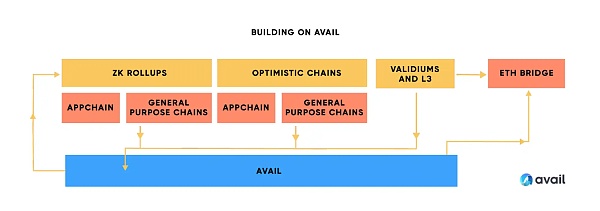
source: https://blog.availproject.org/the-avail-vision-reshaping-the-blockchain-landscape/< /p>
RaaS
RaaS providers are able to combine the complex technologies used to build blockchains Abstract it and help users quickly deploy L2 with one click through simple and easy-to-use tools or even code-free form. As mentioned earlier, the Cancun upgrade will bring about an explosion of L2. The improvement in the ease of use and performance of L2 will also promote the emergence of more L2, thereby benefiting the underlying Rollup as a Service infrastructure.
In the current RaaS solutions, there is also discussion on whether to choose OP or ZK solutions. OP-based solutions have better compatibility, richer ecology and lower threshold. ZK-based solutions have a higher degree of customization and higher security. Although in the long run, ZK-based solutions are more customizable, have stronger dislocation competitiveness, and can bring unique functional and performance capabilities to the project. But in the short term, the OP-based solution can amplify the cost and performance advantages brought by Dencun upgrade to L2 with its advantages of low threshold and high compatibility, reuse the existing complete EVM infrastructure more quickly, and realize early With the rapid expansion of users and funds, the short-term leverage effect is more obvious.
Caldera
Caldera is a RaaS built on OP Stack Service providers can quickly build an Optimism L2 for users in a code-free manner. L2 released using Caldera can achieve complete EVM compatibility, which can greatly reduce the development threshold for developers and facilitate the direct reuse of existing EVM ecological projects, thus providing a more complete infrastructure for L2. In addition to L2 itself, Caldera also configures a series of blockchain infrastructure for users, such as blockchain browsers, test network faucets, etc., thereby further reducing the cost of chain issuance and usage threshold, plug and play.
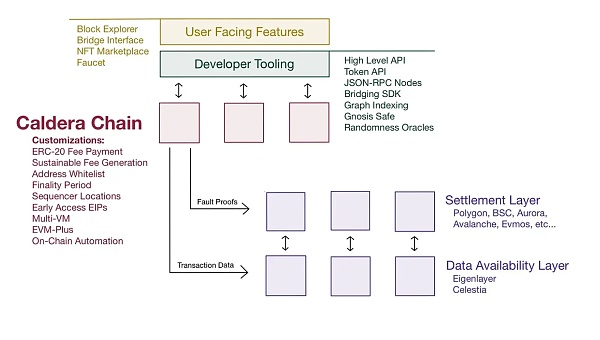
source: https://foresightventures.medium.com/foresight-ventures-what-is-raas-which-type-of -raas-will-win-the-market-b010006f5cd
Altlayer
Altlayer is another noteworthy RaaS solution under the Optimism family. Altlayer supports codeless deployment of L2. Developers only need to perform simple graphical interface operations to quickly create a Rollup chain. In addition, AltLayer also supports flexible Rollup—Flash Layer. When the demand for mainnet applications surges, such as when popular NFT projects start minting or popular DeFi projects issue airdrops, developers can quickly deploy a Rollup chain through Altlayer to respond to the short-term surge in performance demand. When the event ends and the state and assets are transferred back to the base chain, the Flash Layer can be deleted directly. Altlayer provides an instant expansion solution that avoids resource waste and can meet more complex business needs.

source: https://docs.altlayer.io/altlayer-documentation/rollup-types/flash-layer-rollups
Lumoz
Lumoz (formerly Opside) is Building a RaaS solution based on ZK supports developers to deploy their own ZK-Rollup with one click and generate customized zkEVM application chains. At the same time, the emergence of a large number of ZK-Rollups will also create huge computing power requirements for ZKP calculations. Lumoz has also built a decentralized ZKP market to support ZK mining and generate zero-knowledge proofs for ZK-Rollup. In terms of actual use, developers do not need to know anything about ZK and can quickly deploy a ZK-Rollup through simple front-end operations. The computing power requirements involved in the operation of ZK-Rollup can also be solved through the ZK-PoW service provided by Lumoz, which can greatly reduce the operational threshold and operating costs of the project side. In particular, Lumoz also supports 0 Gas Fee contracts, which can provide users with a smooth Dapp experience without interaction costs. The recently popular ZKFair is one of the L2s built on Lumoz.
Application layer
Previously we discussed in detail the impact of Dencun upgrade on L2, DA and RaaS Waiting for the benefits at the track level of Infra. Dencun upgrade’s improvement in L2 cost and performance will also promote the development and innovation of the application layer. Next, we will briefly analyze the application layer tracks that can significantly benefit from Dencun upgrades.
Perps
Overall, in the DeFi track Interaction has the characteristics of low interaction frequency but high single-point interaction revenue. Therefore, in a sense, DeFi does not particularly rely on high performance, and the benefits brought by a single DeFi operation can also well cover the cost of interaction. However, decentralized derivatives are relatively exceptions. The limitations of performance bottlenecks and the shortcomings of excessive network transaction fees will be infinitely amplified during the operation of decentralized derivatives protocols.
Due to the performance limitations of the L2 network, Perps projects are almost unable to run on-chain order books and cannot efficiently respond to real-time order matching needs. Moreover, excessive network fees will greatly limit the high-frequency trading of market makers and high-frequency trading users. The existence of the above problems has resulted in Perps’ low transaction efficiency and relatively high transaction slippage. It is unable to attract deep liquidity and professional trading users, and it cannot provide users with a trading experience comparable to CEX.
We believe that the Dencun upgrade can solve the above problems to a certain extent, especially the improvement in performance is particularly critical for derivatives trading. Compared with point-to-pool and AMM model Perps,Dencun upgrade is more beneficial to L2 Perps decentralized derivatives exchanges with order book models such as ApeX Protocol, Aevo, Vertex Protocol etc. Similarly, the reduction in network transaction fees will further stimulate the trading of more mature point-to-pool model Perps such as GMX, Synthetix, and GNS.
LSD
Dencun upgrade except EIP-4844 Also covered is the introduction of EIP-4788. EIP-4788 will introduce the beacon block root into every EVM block. This allows the Ethereum mainnet to obtain data from the Ethereum consensus layer in a trust-minimized manner, eliminating dependence on external oracles, thereby reducing potential security risks, oracle failure and malicious manipulation risks. The introduction of EIP-4788 can further improve the security of the staking protocol. Although this improvement is not direct for users, it is a potentially significant benefit to LSD and the ReStaking track. EIP-4788 enables liquidity staking protocols such as Lido, Rocketpool, Swell, and re-staking protocols such as Eigenlayer to directly access key data such as validator balances and status from the consensus layer, thereby significantly improving their security and operational efficiency. We still have high expectations for Dencun’s upgraded LSD, especially for the development of the ReStaking track represented by Eigenlayer. Eigenlayer has also been active recently and has successively supported a variety of LSTs. It has cooperated with Altlayer to launch Restaked Rollups, the ecological re-pledge protocol Renzo has been launched, and EigenDA has also opened the second phase of the test network. Eigenlayer’s TVL has also reached 1.7B and continues to rise. The narrative of re-staking has just emerged, and EIP-4788 will provide a solid underlying security guarantee for re-staking.
FOCG
Full-chain games are the ultimate upgrade for Dencun One of the big beneficiaries. Different from Web2.5 games where only the assets are on the chain and the main body of the game is still off-chain, the game content, logic, rules, and assets of the full-chain game are all on the chain. The gas fee on the chain determines the interaction cost of each game operation, and the performance on the chain determines the player's user experience. Obviously, due to performance limitations, previous full-chain games were limited to simpler turn-based strategy games. The high cost of interaction and the game’s need for high-frequency interaction also discourage many players.
Dencun upgrade can intuitively improve the development dilemma of existing full-chain games, and even spawn more full-chain game types. We are optimistic that more full-chain games will be built based on full-chain game engines such as Mud and Dojo and run on L2 Redstone and StarkNet. Existing full-chain games such as Sky Strife, Loot Survivor, Isaac, and Influence may also capture more real players due to the improvement in user experience brought about by the Dencun upgrade.
The implementation of the Dencun upgrade will once again inject new vitality into the Ethereum ecosystem. Of course, in addition to benefiting the tracks mentioned above, the Dencun upgrade will also reduce the attractiveness and core competitiveness of some tracks such as side chains and non-EVM expansion solutions. The substantial cost reduction and performance improvement of EVM ecosystem L2 and L3 will further eclipse sidechain solutions such as Polygon, and non-EVM expansion solutions such as BSC will also reduce the attractiveness brought by cost and performance advantages. The Dencun upgrade will refocus the market on the Ethereum ecosystem with L2 and L3 as the core.
Summary:
1.Dencun upgrade as "The Surge" in the Ethereum upgrade roadmap ” is designed to further reduce the cost of using the Ethereum ecosystem and improve the scalability of the Ethereum ecosystem. The Dencun upgrade will introduce instant storage operation codes through EIP-1153, reducing the storage cost and gas consumption of the Ethereum main network, and improving the scalability of the main network. The Dencun upgrade will also introduce EIP-4844, which will significantly reduce the transaction cost of Ethereum L2 and improve the transaction throughput of L2 by introducing a new data structure blob.
2. Judging from the current Shadowfork test report and the recently held 178th Ethereum Core Developer Executive Meeting, the current testing situation of the Ethereum Dencun upgrade Good. The three major testnets will conduct testnet Dencun upgrade tests respectively from January to early February as expected. If the testnet test goes smoothly, the Dencun upgrade of the mainnet is expected to be completed within February.
3. The Dencun upgrade will further promote the prosperity of the L2 ecosystem. Optimism, Arbitrum and Metis are particularly worthy of attention. The Dencun upgrade will also drive demand for Infra tracks such as decentralized storage, DA and RaaS. The development of ecological projects such as EthStorage, Covalent, EigenDA, Polygon Avail, Caldera, Altlayer, and Lumoz deserves attention.
4.Dencun upgrade will also promote the development and innovation of the application layer. The order book model Perps represented by ApeX Protocol, Aevo**, and **Vertex Protocol will benefit significantly. EIP-4788 will improve the underlying security of LSD and ReStaking protocols, and will especially drive the development of the re-staking track represented by EigenLayer. The entire chain of games will also bring a better interactive experience to users due to the Dencun upgrade.
Finally: MT Capital is very optimistic about the EVM ecological innovation brought about by the Dencun upgrade, and welcomes early adopters of ReStaking, DA, L2, Perps, FOCG and other tracks Projects and entrepreneurs feel free to contact us. (Twitter: @0X_IanWu, @Severin0624, MT Capital Email: [email protected])
Reference:
https://vitalik.eth.limo/general/2023/12/28/cypherpunk.html
https://www.datawallet.com/crypto/ethereum-cancun-upgrade-explained#:~:text=Ethereum Cancun EIPs,- The imminent Ethereum&text=The Cancun component of the,costs%2C efficiently using block space.
https://ethereum- magicians.org/t/a-rollup-centric-ethereum-roadmap/4698
https://www.eip4844.com /#how
https://a16zcrypto.com/posts/article/an-overview-of-danksharding-and-a -proposal-for-improvement-of-das/
https://hacken.io/discover/eip-4844-explained /
Ethereum Evolved: Dencun Upgrade Part 3, EIP-4788
EIP-4844 Unveiled: Paving the Way for Proto-Danksharding in Ethereum
EIP- 4844: Shard Blob Transactions
An explanation of the sharding + DAS proposal
Ethereum's Cancun-Deneb (Dencun) Upgrade: another milestone after the Shanghai Upgrade
Recapping the Rollups Roadmap
Ethereum: Dencun Upgrade and Proto-Danksharding
Unlocking Ethereum's Evolution: The Cancun Advancement
https://hackmd.io/@ vbuterin/sharding_proposal#ELI5-data-availability-sampling
dencun-gsf-1 analysis
https://foresightnews.pro/article/detail/28606
https://foresightnews.pro/article/detail/40103
https://foresightnews.pro/article/detail /51220
https://bitpush.news/articles/5743354
https://www.techflowpost.com/article/detail_15286.html
https://foresightnews.pro/article/detail/43926
https://foresightnews.pro/article/detail/35645
https://www.techflowpost.com/article/detail_15313.html
-
https://foresightnews.pro/article/detail/20033
https://www.techflowpost.com/article/detail_12801.html
https://foresightnews.pro/article/detail /51217
https://docs.eigenlayer.xyz/eigenda-guides/eigenda-overview
https://docs.altlayer.io/altlayer-documentation/rollup-types/flash-layer-rollups
https://foresightnews.pro/article/detail/27148
 JinseFinance
JinseFinance

